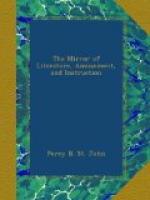We now come to the most peculiar parts of the structure of the Cuttle-fish, viz. the ear and eye, inasmuch as it is the only animal of its class, in which any thing has hitherto been discovered, at all like an organ of hearing, or that has been shown to possess true eyes.[10] The ears consist of two oval cavities, in the cartilaginous ring, to which the large arms of the animal are affixed. In each of these is a small bag, containing a bony substance, and receiving the termination of the nerves, like those of the vestibulum (or cavity in the bone of the ear) in fishes. The nature of the eyes cannot be disputed. “They resemble, on the whole, those of red-blooded animals, particularly fishes; they are at least incomparably more like them than the eyes of any known insects; yet they are distinguished by several extraordinary peculiarities. The front of the eye-ball is covered with a loose membrane instead of a cornea; the iris is composed of a firm substance; and a process projects from the upper margin of the pupil, which gives that membrane a semilunar form."[11] The exterior coat or ball is remarkably strong, so as to seem almost calcareous, and is, when taken out, of a brilliant pearl colour; it is worn in some parts of Italy, and in the Grecian islands by way of artificial pearl in necklaces.
[10] In all other worms the eyes
are entirely wanting, or their
existence is very doubtful. Whether
the black points at the
extremities of what Swammerdam calls the
horns of the common
snail, are organs which really possess the
power of vision,
is still problematical.
[11] Blumenbach, Man. Comp. Anat. p. 305.
Next we may notice the curious provision by which the Cuttle-fish is enabled to elude the pursuit of its enemies in the “vasty deep.” This consists of a black, inky fluid, (erroneously supposed to be the bile,) which is contained in a bag beneath the body. The fluid itself is thick, but miscible with water to such a degree, that a very small quantity will colour a vast bulk of water.[12] Thus, the comparatively small Cuttle-fish may darken the element about the acute eye of the whale. What omniscience is displayed in this single provision, as well as in the faculty possessed by the Cuttle-fish of reproducing its mutilated arms! All Nature beams with such beneficence, and abounds with such instances of divine love for every creature, however humble: in observing these provisions, how often are we reminded of the benefits conferred by the same omniscience upon our own species. It is thus, by the investigation of natural history, that we are led to the contemplation of the sublimest subjects; thus that man with God himself holds converse.
BONE, OR PLATE.
[Illustration: Bone, or Plate.]




